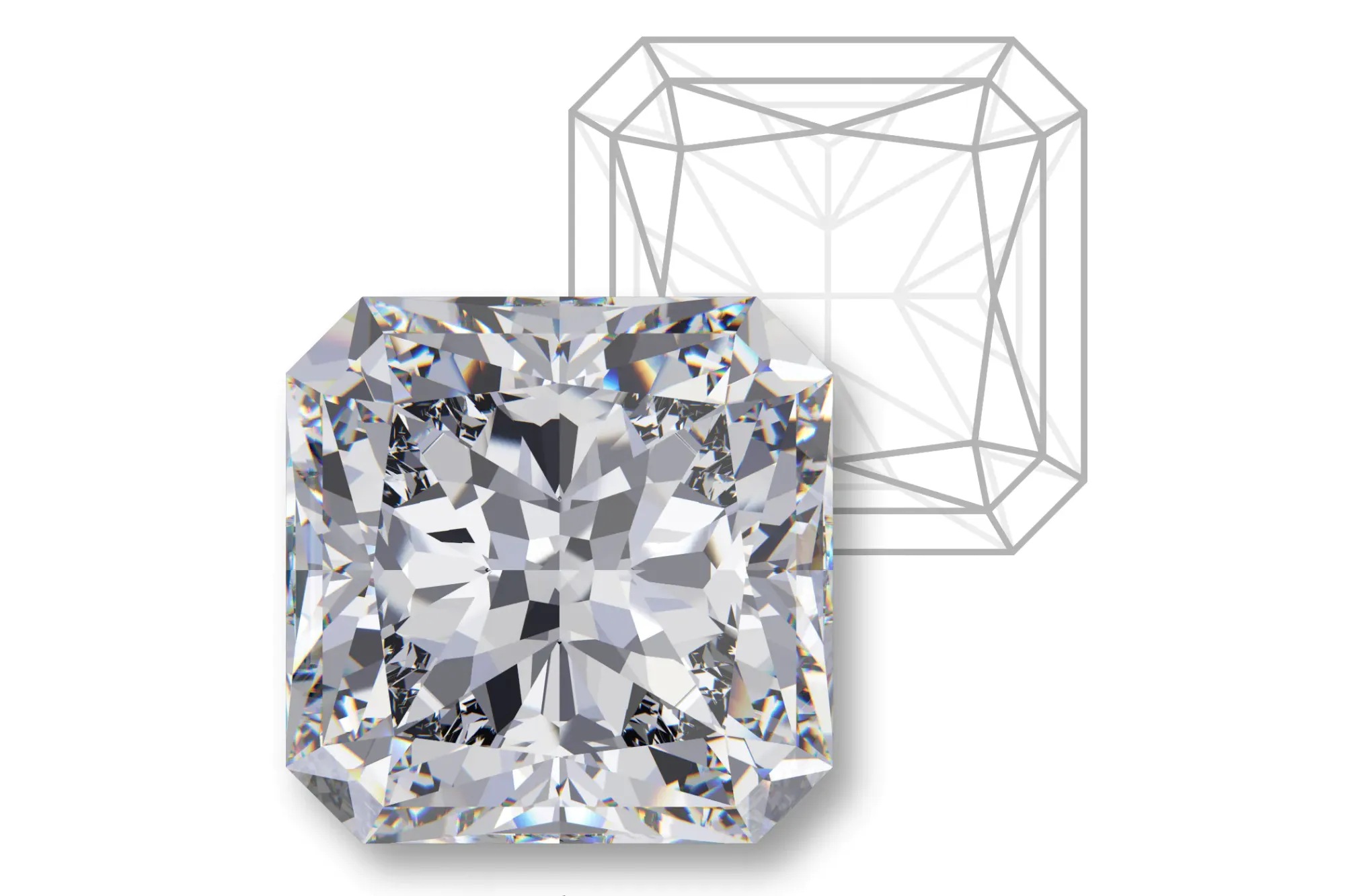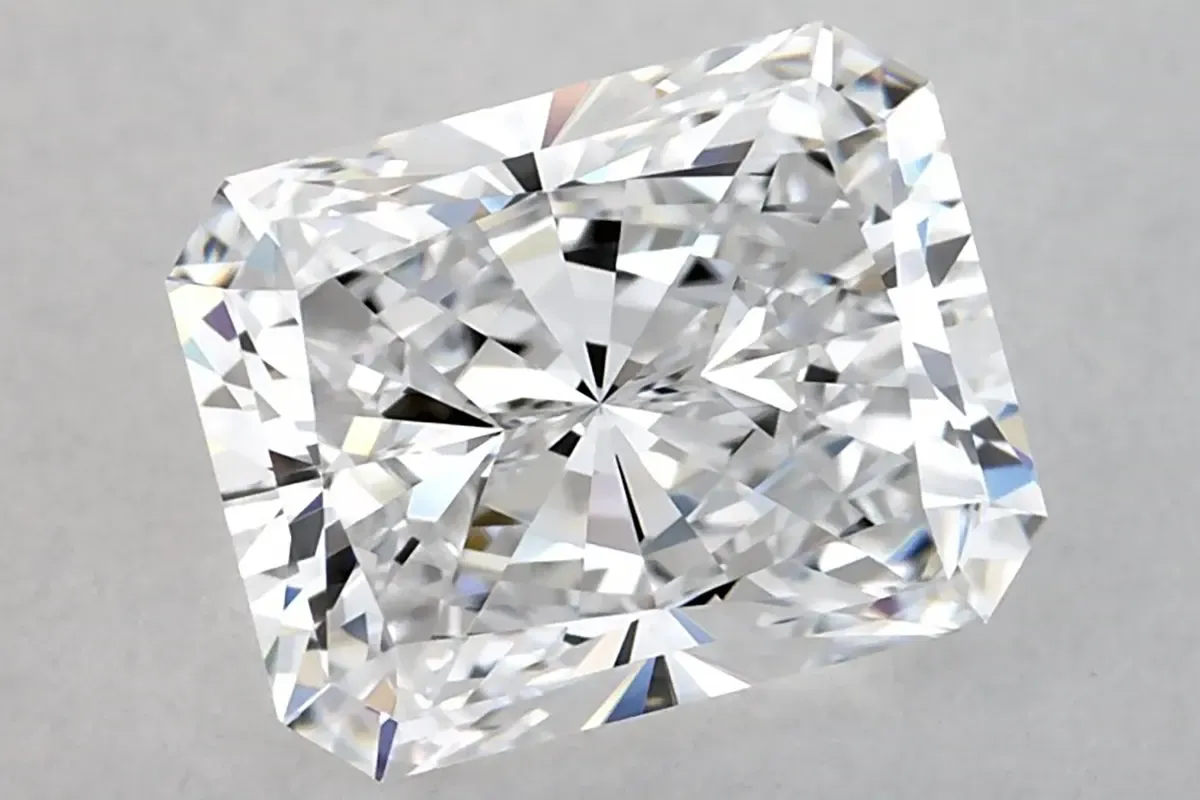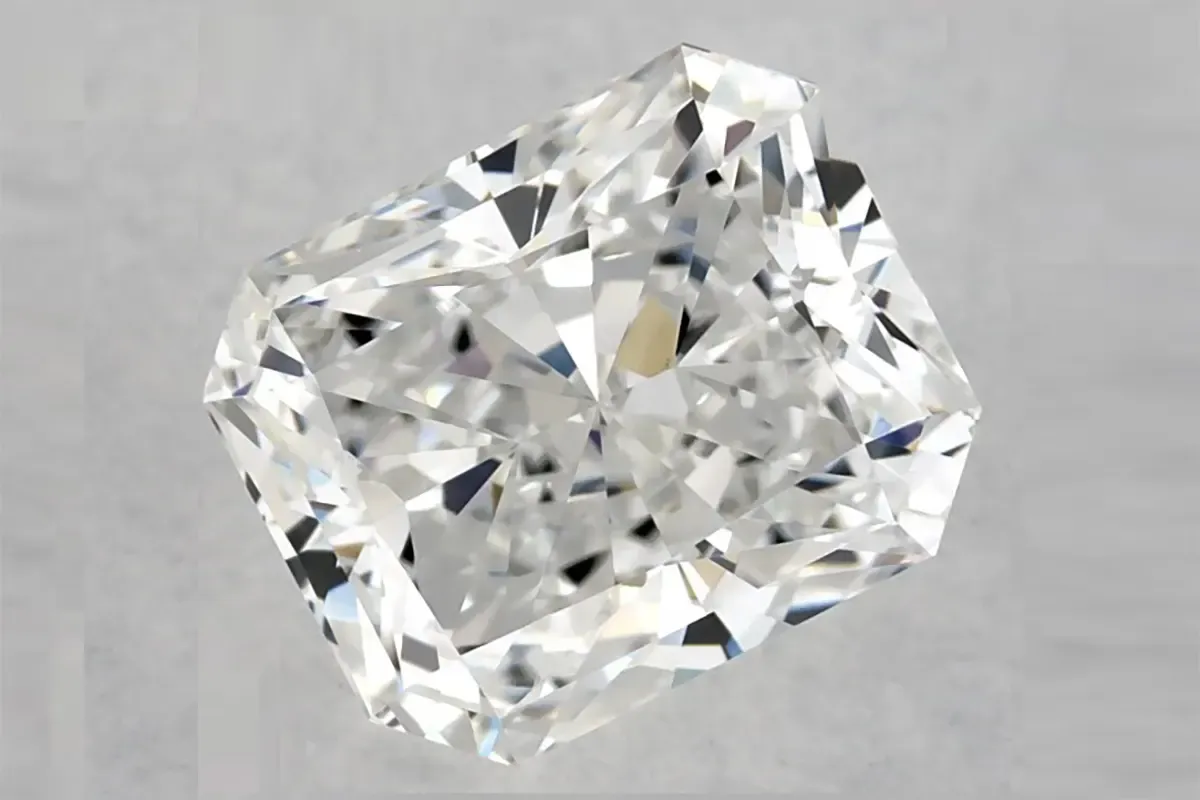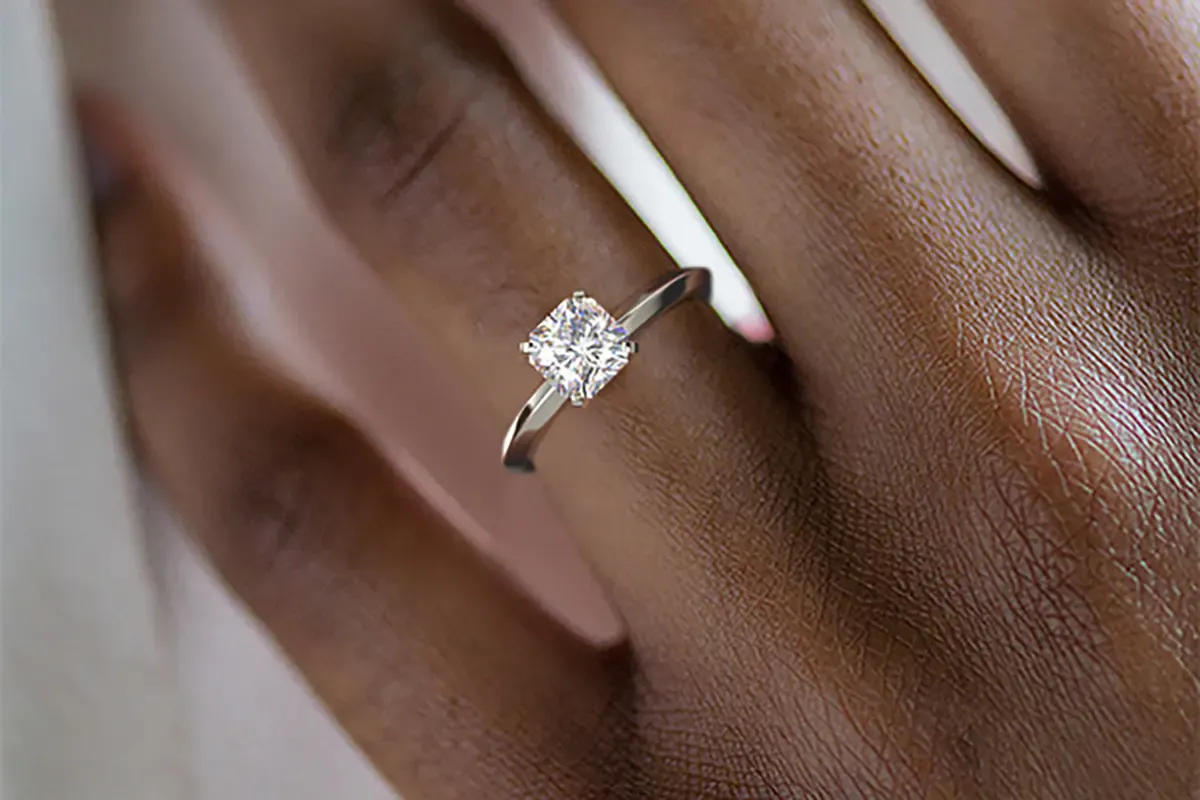Displaying breathtaking sparkle and stunning fire, the radiant cut is perfect for engagement rings. A relative newcomer, the radiant diamond was created only 45 years ago and combines the octagonal silhouette and open table of an emerald cut with the glittering sparkle of a round brilliant cut.
Radiant cut diamonds can be either rectangular or square, with the rectangular shape being more popular. They are perfect if you love the outline of an emerald cut, but want lively sparkle - in fact, they're one of the sparkliest cuts around.
So how do you choose a radiant cut diamond that is full of beauty, and how do you know you're spending your money wisely? I'll talk you through how to evaluate the quality of a radiant cut, which color and clarity grades to choose, and other potential pitfalls when buying this particular diamond shape.
First up, let's dive into what makes a radiant cut unique and how to evaluate shape and cut...

Radiant cut diamonds: cut quality
The radiant cut is what's known as a mixed cut, combining different facet styles into one diamond. Take a look at the illustration below. You'll see that the crown of the diamond (the top part) includes rectangular 'step cut' facets, but that the other facets look like the triangular ones found in round brilliant diamond.

It's these brilliant cut facets that give the radiant cut diamond its incredible sparkle. And of the 4 Cs (Cut, Clarity, Color and Carat), cut quality is the single biggest factor determining the beauty of a diamond.
Cut quality can be tricky to evaluate for a fancy cut diamond like the radiant, as there is variety in shape and therefore cutting style. But it's by no means impossible.
Cut Quality: shape & silhouette
First, consider the outline of the diamond that you're looking at. Whether you're choosing a square or rectangular radiant cut, these diamonds should have perfectly straight, parallel sides. This sets the radiant cut apart from the cushion cut, another rectangular(ish) shape which has gently curved sides.
The four corners of a radiant cut are clipped, and it's down to personal preference as to whether you like smaller corner cuts or wider ones. Note that small corners will be hidden by the prongs in most engagement ring settings, as you can see here. This means that for square radiant cuts, they will have virtually the same appearance in an engagement ring with corner prongs as a princess cut, but the cropped corners of a radiant diamond are more stable and less prone to chipping.



The small corners of the radiant cut on the left give a different feel to the wider corners shown in the center. Make sure corners are cut evenly unlike in the third example!
Additionally, check for symmetry of shape. If a diamond looks 'off' it probably is - corners should be cut evenly, sides should be parallel and perfectly straight and the culet (little point on the underside) should be central.
Cut Quality: the bow-tie effect
The more elongated, rectangular shaped radiant cut diamonds can show what's called the 'bow-tie effect'. This is a dark band across the middle in the shape of - yes, that's right - a bow tie. And whilst a bow tie makes for dapper occasion wear, it's something to avoid in a diamond. Elongated and asymmetric diamond shapes are more prone to these dark middles due to the facet structure.

A bow-tie is a dark area where facets are not sufficiently reflecting light. The severity of the effect can vary widely, and bow-tie effect is not listed on a diamond certificate - you need to look at the diamond from multiple angles in a video or in person to check the severity. What you're looking for is even contrast, like in this stunning 1.8 carat radiant cut listed on James Allen. You can see the evenly distributed light and dark areas which will ensure impressive sparkle.
Cut Quality: recommended proportions
Radiant cut diamonds usually have 70 facets, but there is some variation. And there there are many different proportions and facet alignments that can produce a spectacular radiant diamond. There is no official cut grade for radiant diamonds, so you won't see one on a diamond certificate. If a cut grade is assigned, it is the vendor categorizing the quality, and you need to assess the diamond for yourself. So, here's your checklist:
- Check for symmetry of shape with even corners and parallel sides
- Look out for the bow-tie effect
- Check the culet (bottom point) is central
- As a minimum, check table and depth proportions. Too deep or shallow, and light is lost from the diamond, making it dull.
And whilst there are no official proportions to look out for, we've collated our own recommended proportions below. Sticking to these proportions will help you choose a radiant diamond with excellent light performance which means plenty of sparkle.
Radiant Cut |
Excellent | Very Good | Good |
|---|---|---|---|
| Table % | 61 - 67 | 58 - 60 or 68 - 70 | 55 - 57 or 71 - 73 |
| Depth % | 61 - 67 | 59 - 60 or 68 - 70 | 57 - 59 or 71 - 74 |
| Girdle | thin - slightly thick | very thin - thick | very thin - very thick |
| Culet | none | very small | small |
Square or rectangle? Best length to width ratio.
Radiant cut diamonds can be either rectangular or square. The 'go to' ratios for a pleasing rectangular diamond are between 1.2 and 1.35 (the number is simply the length divided by the width). That said, it's a purely aesthetic choice, so if you like a longer thinner shape or a stockier shape then go for it! Simply adjust the ratio filter to 1.4 or above for longer rectangles (some sites include a ratio filter in the advanced options).
Square radiants are often picked as an alternative to a princess cut because they are full of sparkle as well as being more durable with those clipped corners. If you're looking for a square radiant cut set your filters to 1.05 or below. Whilst '1' is a true square, the untrained eye certainly can't notice anything wrong with a diamond under 1.05.

Radiant diamonds: which clarity grade is best?
Clarity grading is a measure of how free from impurities and blemishes a diamond is - our guide to the grades is here. The sheer quantity of facets in a radiant diamond means that there are plenty of places for inclusions to hide, so you can afford to go lower on the clarity grades for a radiant cut and still get an eye-clean diamond. We recommend you stick to VS2 or above.
Be sure to check the location and severity of flaws - a dark inclusion near the middle of the stone is likely to be visible to the naked eye due to the large table facet. Compare this 1.01 carat VS2 diamond from Blue Nile with this 1.03 carat diamond: both are graded VS2 but the central flaw in the first is a very different proposition to the less severe flaws in the second (additionally, the 'feather' in the second diamond would be covered by a prong in many ring designs, so a good buy).
Ultimately there is no 'correct' grade to pick - it depends if you are looking for a more technically flawless diamond or for the best value. And remember, the larger the diamond the more visible the flaws, so if you're looking at diamonds of 2 carats or more we recommend a minimum clarity grade of VVS2-VS1.

The simple, sharp knife edge on a ring like this accentuates the straight edged geometry of a radiant cut.
Radiant diamonds: which color grade?
Radiant diamonds are full of sparkle which usually hides a bit of color, however the facet arrangement and large table can actually intensify the color of the diamond. When browsing diamonds you'll notice that some radiants have slightly easier to see, larger looking facets while others have smaller, busier looking facets (usually referred to as the 'crushed ice' effect). Radiants with the crushed ice effect often intensify body color and are a go-to cut for colored diamonds such as yellow diamonds. Therefore if you are looking for a white, colorless diamond you should stick to higher grades D-F, though for diamonds of 1 carat or under G will also appear white. Our full guide to color grades is here.
If you prefer a warmer colored diamond, or are setting your diamond in gold, the lower grades of G, H, or even I can be a better choice. The warmth of the gold will complement a yellower diamond.
Just be mindful not to set a completely colorless diamond in a gold setting - the slightly yellow light reflected from the metal would negate the true whiteness of the diamond.

White metals set off colorless diamonds to perfection. French set pavé diamonds on the band of this ring accentuate the sparkle of the center stone to dazzling effect.
Are radiant cuts more expensive?
Radiant cut diamonds are less expensive than many other diamond shapes. This is because the rectangular shape uses more of the diamond's original rough stone than other cuts. Less wastage = less expensive.
Plus, the sparkle of the cut means you don't have to spend money on a higher clarity grade. What's not to love?!
So, let's summarize....
I really hope this article has left you feeling equipped to hunt out your diamond with confidence. To buy a radiant cut engagement ring that will catch your breath with its sparkle:
- Check cut quality closely. Look at the overall shape and avoid the bow-tie effect.
- Stick to a table % of 68-70 and a depth % of 59-70.
- A clarity grade of VS2 or up will be eye-clean.
- Radiants cut with the crushed ice effect can intensify color. Stick to higher color grades D through F, or as low as G for radiants under 1 carat.
And finally, working out your priorities and preferences will help you find the right diamond ring and it'll make your budget work harder. Whilst we always recommend prioritizing cut quality, when it comes to the other three Cs (clarity, color and carat), work out your preferences so you're paying for the qualities you appreciate the most. Happy shopping!

